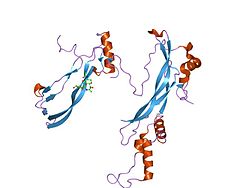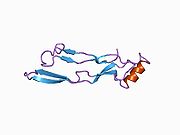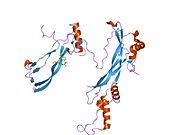- Bone morphogenetic protein 7
-
For the portable synthesizer, see OP-1.
Bone morphogenetic protein 7 or BMP7 (also known as osteogenic protein-1 or OP-1) is a protein that in humans is encoded by the BMP7 gene.[1]
Contents
Function
The protein encoded by this gene is a member of the TGF-β superfamily. Like other members of the bone morphogenetic protein family of proteins, it plays a key role in the transformation of mesenchymal cells into bone and cartilage. It is inhibited by noggin and a similar protein, chordin, which are expressed in the Spemann-Mangold Organizer. BMP7 may be involved in bone homeostasis. It is expressed in the brain, kidneys and bladder.[2]
BMP7 induces the phosphorylation of SMAD1 and SMAD5, which in turn induce transcription of numerous osteogenic genes.[3] It has been demonstrated that BMP7 treatment is sufficient to induce all of the genetic markers of osteoblast differentiation in many cell types.[2]
Role in vertebrate development
BMP7 has been discovered to be crucial in the determination of ventral-dorsal organization in zebrafish. BMP7 causes the expression of ventral phenotypes while its complete inhibition creates a dorsal phenotype. Moreover, BMP7 is eventually partially "turned off" in embryonic development in order to create the dorsal parts of the organism.[4]
In many early developmental experiments using zebrafish, scientists used caBMPR (constitutively active) and tBMP (truncated receptor) to determine the effect of BMP7 in embryogensis. They found that the constitutively active, which causes BMP to be expressed everywhere creates a ventralized phenotype, whereas truncated, dorsalized.
Therapeutic application
Human recombinant BMP7 has surgical uses and is marketed under the brand name OP1 (sold by Stryker). It can be used to aid in the fusion of vertebral bodies to prevent neurologic trauma.[5] Also in the treatment of tibial non-union, frequently in cases where a bone graft has failed.[6]
BMP7 also has the potential for treatment of chronic kidney disease.[7][8]
BMP7 administration has been proposed as a possible treatment for human infertility due to poor response to FSH treatment.[9]
Promotion of brown fat
It was discovered that mice injected with BMP7 increased their production of "good" brown fat cells, while keeping their levels of the normal white fat cells constant. A BMP7 therapy for obesity in humans may be developed as a result.[10][11]
References
- ^ Hahn GV, Cohen RB, Wozney JM, Levitz CL, Shore EM, Zasloff MA, Kaplan FS (November 1992). "A bone morphogenetic protein subfamily: chromosomal localization of human genes for BMP5, BMP6, and BMP7". Genomics 14 (3): 759–62. doi:10.1016/S0888-7543(05)80181-8. PMID 1427904.
- ^ a b Chen D, Zhao M, Mundy GR (December 2004). "Bone morphogenetic proteins". Growth Factors 22 (4): 233–41. doi:10.1080/08977190412331279890. PMID 15621726.
- ^ Itoh F, Asao H, Sugamura K, Heldin CH, ten Dijke P, Itoh S (August 2001). "Promoting bone morphogenetic protein signaling through negative regulation of inhibitory Smads". EMBO J. 20 (15): 4132–42. doi:10.1093/emboj/20.15.4132. PMC 149146. PMID 11483516. http://www.pubmedcentral.nih.gov/articlerender.fcgi?tool=pmcentrez&artid=149146.
- ^ Myers DC, Sepich DS, Solnica-Krezel L (March 2002). "Bmp activity gradient regulates convergent extension during zebrafish gastrulation". Dev. Biol. 243 (1): 81–98. doi:10.1006/dbio.2001.0523. PMID 11846479.
- ^ Vaccaro AR, Whang PG, Patel T, Phillips FM, Anderson DG, Albert TJ, Hilibrand AS, Brower RS, Kurd MF, Appannagari A, Patel M, Fischgrund JS (2008). "The safety and efficacy of OP-1 (rhBMP-7) as a replacement for iliac crest autograft for posterolateral lumbar arthrodesis: minimum 4-year follow-up of a pilot study". Spine J 8 (3): 457–65. doi:10.1016/j.spinee.2007.03.012. PMID 17588821.
- ^ Zimmermann G, Müller U, Löffler C, Wentzensen A, Moghaddam A (November 2007). "[Therapeutic outcome in tibial pseudarthrosis: bone morphogenetic protein 7 (BMP-7) versus autologous bone grafting for tibial fractures]" (in German). Unfallchirurg 110 (11): 931–8. doi:10.1007/s00113-007-1347-y. PMID 17989951.
- ^ Gould SE, Day M, Jones SS, Dorai H (January 2002). "BMP-7 regulates chemokine, cytokine, and hemodynamic gene expression in proximal tubule cells". Kidney Int. 61 (1): 51–60. doi:10.1046/j.1523-1755.2002.00103.x. PMID 11786084.
- ^ González EA, Lund RJ, Martin KJ, McCartney JE, Tondravi MM, Sampath TK, Hruska KA (April 2002). "Treatment of a murine model of high-turnover renal osteodystrophy by exogenous BMP-7". Kidney Int. 61 (4): 1322–31. doi:10.1046/j.1523-1755.2002.00258.x. PMID 11918739.
- ^ Shi J, Yoshino O, Osuga Y, Nishii O, Yano T, Taketani Y (March 2010). "Bone morphogenetic protein 7 (BMP-7) increases the expression of follicle-stimulating hormone (FSH) receptor in human granulosa cells". Fertil. Steril. 93 (4): 1273–9. doi:10.1016/j.fertnstert.2008.11.014. PMID 19108831.
- ^ Jha A (2008-08-21). "Obesity: Scientists identify protein that promotes fat-burning". Science. guardian.co.uk. http://www.guardian.co.uk/science/2008/aug/21/brown.fat.obesity. Retrieved 2008-09-03.
- ^ Tseng YH, Kokkotou E, Schulz TJ, Huang TL, Winnay JN, Taniguchi CM, Tran TT, Suzuki R, Espinoza DO, Yamamoto Y, Ahrens MJ, Dudley AT, Norris AW, Kulkarni RN, Kahn CR (August 2008). "New role of bone morphogenetic protein 7 in brown adipogenesis and energy expenditure". Nature 454 (7207): 1000–4. doi:10.1038/nature07221. PMC 2745972. PMID 18719589. http://www.pubmedcentral.nih.gov/articlerender.fcgi?tool=pmcentrez&artid=2745972.
Further reading
- Xiao HQ, Shi W, Zhang Y, Liang YZ (2009). "[Effect of bone morphogenic protein 7 on nephrin expression and distribution in diabetic rat kidneys]". Nan Fang Yi Ke Da Xue Xue Bao 29 (4): 671–5. PMID 19403392.
- Murray LA, Hackett TL, Warner SM, et al. (2008). Eickelberg, Oliver. ed. "BMP-7 does not protect against bleomycin-induced lung or skin fibrosis.". PLoS ONE 3 (12): e4039. doi:10.1371/journal.pone.0004039. PMC 2603595. PMID 19112509. http://www.pubmedcentral.nih.gov/articlerender.fcgi?tool=pmcentrez&artid=2603595.
- Freedman BI, Bowden DW, Ziegler JT, et al. (2009). "Bone morphogenetic protein 7 (BMP7) gene polymorphisms are associated with inverse relationships between vascular calcification and BMD: the Diabetes Heart Study". J. Bone Miner. Res. 24 (10): 1719–27. doi:10.1359/jbmr.090501. PMC 2743282. PMID 19453255. http://www.pubmedcentral.nih.gov/articlerender.fcgi?tool=pmcentrez&artid=2743282.
- Garriock HA, Kraft JB, Shyn SI, et al. (2010). "A genomewide association study of citalopram response in major depressive disorder". Biol. Psychiatry 67 (2): 133–8. doi:10.1016/j.biopsych.2009.08.029. PMC 2794921. PMID 19846067. http://www.pubmedcentral.nih.gov/articlerender.fcgi?tool=pmcentrez&artid=2794921.
- Reddi AH (2000). "Bone morphogenetic proteins and skeletal development: the kidney-bone connection". Pediatr. Nephrol. 14 (7): 598–601. doi:10.1007/s004670000364. PMID 10912525.
- Gautschi OP, Cadosch D, Zellweger R, et al. (2009). "Apoptosis induction and reduced proliferation in human osteoblasts by rhBMP-2, -4 and -7". J Musculoskelet Neuronal Interact 9 (1): 53–60. PMID 19240369.
- Alarmo EL, Pärssinen J, Ketolainen JM, et al. (2009). "BMP7 influences proliferation, migration, and invasion of breast cancer cells". Cancer Lett. 275 (1): 35–43. doi:10.1016/j.canlet.2008.09.028. PMID 18980801.
- Elshaier AM, Hakimiyan AA, Rappoport L, et al. (2009). "Effect of interleukin-1beta on osteogenic protein 1-induced signaling in adult human articular chondrocytes". Arthritis Rheum. 60 (1): 143–54. doi:10.1002/art.24151. PMC 2626196. PMID 19116903. http://www.pubmedcentral.nih.gov/articlerender.fcgi?tool=pmcentrez&artid=2626196.
- Yerges LM, Klei L, Cauley JA, et al. (2009). "High-density association study of 383 candidate genes for volumetric BMD at the femoral neck and lumbar spine among older men". J. Bone Miner. Res. 24 (12): 2039–49. doi:10.1359/jbmr.090524. PMC 2791518. PMID 19453261. http://www.pubmedcentral.nih.gov/articlerender.fcgi?tool=pmcentrez&artid=2791518.
- Dudas PL, Argentieri RL, Farrell FX (2009). "BMP-7 fails to attenuate TGF-beta1-induced epithelial-to-mesenchymal transition in human proximal tubule epithelial cells". Nephrol. Dial. Transplant. 24 (5): 1406–16. doi:10.1093/ndt/gfn662. PMID 19056781.
- Honsawek S, Chayanupatkul M, Tanavalee A, et al. (2009). "Relationship of plasma and synovial fluid BMP-7 with disease severity in knee osteoarthritis patients: a pilot study". Int Orthop 33 (4): 1171–5. doi:10.1007/s00264-009-0751-z. PMC 2898966. PMID 19301001. http://www.pubmedcentral.nih.gov/articlerender.fcgi?tool=pmcentrez&artid=2898966.
- Sengle G, Ono RN, Lyons KM, et al. (2008). "A new model for growth factor activation: type II receptors compete with the prodomain for BMP-7". J. Mol. Biol. 381 (4): 1025–39. doi:10.1016/j.jmb.2008.06.074. PMC 2705212. PMID 18621057. http://www.pubmedcentral.nih.gov/articlerender.fcgi?tool=pmcentrez&artid=2705212.
- Mitu G, Hirschberg R (2008). "Bone morphogenetic protein-7 (BMP7) in chronic kidney disease". Front. Biosci. 13: 4726–39. PMID 18508541.
- Brown A, Stock G, Patel AA, et al. (2006). "Osteogenic protein-1 : a review of its utility in spinal applications". BioDrugs 20 (4): 243–51. PMID 16831023.
- Fajardo M, Liu CJ, Egol K (2009). "Levels of expression for BMP-7 and several BMP antagonists may play an integral role in a fracture nonunion: a pilot study". Clin. Orthop. Relat. Res. 467 (12): 3071–8. doi:10.1007/s11999-009-0981-9. PMC 2772945. PMID 19597895. http://www.pubmedcentral.nih.gov/articlerender.fcgi?tool=pmcentrez&artid=2772945.
- Giannoudis PV, Kanakaris NK, Dimitriou R, et al. (2009). "The synergistic effect of autograft and BMP-7 in the treatment of atrophic nonunions". Clin. Orthop. Relat. Res. 467 (12): 3239–48. doi:10.1007/s11999-009-0846-2. PMC 2772926. PMID 19396502. http://www.pubmedcentral.nih.gov/articlerender.fcgi?tool=pmcentrez&artid=2772926.
- Kalluri R, Neilson EG (2003). "Epithelial-mesenchymal transition and its implications for fibrosis". J. Clin. Invest. 112 (12): 1776–84. doi:10.1172/JCI20530. PMC 297008. PMID 14679171. http://www.pubmedcentral.nih.gov/articlerender.fcgi?tool=pmcentrez&artid=297008.
- Zhu L, Chuanchang D, Wei L, et al. (2010). "Enhanced healing of goat femur-defect using BMP7 gene-modified BMSCs and load-bearing tissue-engineered bone". J. Orthop. Res. 28 (3): 412–8. doi:10.1002/jor.20973. PMID 19725097.
- Vieira AR, McHenry TG, Daack-Hirsch S, et al. (2008). "Candidate gene/loci studies in cleft lip/palate and dental anomalies finds novel susceptibility genes for clefts". Genet. Med. 10 (9): 668–74. doi:10.1097/GIM.0b013e3181833793. PMC 2734954. PMID 18978678. http://www.pubmedcentral.nih.gov/articlerender.fcgi?tool=pmcentrez&artid=2734954.
- Kron K, Pethe V, Briollais L, et al. (2009). Blagosklonny, Mikhail V.. ed. "Discovery of novel hypermethylated genes in prostate cancer using genomic CpG island microarrays". PLoS ONE 4 (3): e4830. doi:10.1371/journal.pone.0004830. PMC 2653233. PMID 19283074. http://www.pubmedcentral.nih.gov/articlerender.fcgi?tool=pmcentrez&artid=2653233.
External links
PDB gallery Cell signaling: TGF beta signaling pathway TGF beta superfamily of ligands TGF beta family (TGF-β1, TGF-β2, TGF-β3)
Bone morphogenetic proteins (BMP2, BMP3, BMP4, BMP5, BMP6, BMP7, BMP8a, BMP8b, BMP10 , BMP15)
Growth differentiation factors (GDF1, GDF2, GDF3, GDF5, GDF6, GDF7, Myostatin/GDF8, GDF9, GDF10, GDF11, GDF15)
Other (Activin and inhibin, Anti-müllerian hormone, Nodal)TGF beta receptors
(Activin, BMP)TGFBR1: Activin type 1 receptors (ACVR1, ACVR1B, ACVR1C) · ACVRL1 · BMPR1 (BMPR1A · BMPR1B)
TGFBR2: Activin type 2 receptors (ACVR2A, ACVR2B) · AMHR2 · BMPR2
TGFBR3: betaglycanTransducers/SMAD Ligand inhibitors Coreceptors Other SARAB trdu: iter (nrpl/grfl/cytl/horl), csrc (lgic, enzr, gprc, igsr, intg, nrpr/grfr/cytr), itra (adap, gbpr, mapk), calc, lipd; path (hedp, wntp, tgfp+mapp, notp, jakp, fsap, hipp, tlrp) Categories:- Human proteins
- Bone morphogenetic protein
- Developmental genes and proteins
- TGFβ domain
Wikimedia Foundation. 2010.





